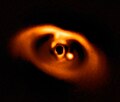Nomenclature and history

Prior to Kepler observation, Kepler-61 had the 2MASS catalogue number 2MASS J19411308+422831. In the Kepler Input Catalog it has the designation of KIC 6960913, and when it was found to have transiting planet candidates it was given the Kepler object of interest number of KOI-1361.
Planetary candidates were detected around the star by NASA's Kepler Mission, a mission tasked with discovering planets in transit around their stars. The transit method that Kepler uses involves detecting dips in brightness in stars. These dips in brightness can be interpreted as planets whose orbits pass in front of their stars from the perspective of Earth, although other phenomenon can also be responsible which is why the term planetary candidate is used. [8]
Following the acceptance of the discovery paper, the Kepler team provided an additional moniker for the system of "Kepler-61". [9] The discoverers referred to the star as Kepler-61, which is the normal procedure for naming the exoplanets discovered by the spacecraft. [4] Hence, this is the name used by the public to refer to the star and its planet.
Candidate planets that are associated with stars studied by the Kepler Mission are assigned the designations ".01" etc. after the star's name, in the order of discovery. [10] If planet candidates are detected simultaneously, then the ordering follows the order of orbital periods from shortest to longest. [10] Following these rules, there was only one candidate planet were detected, with an orbital period of 59.87756 days.
The designation b, derive from the order of discovery. The designation of b is given to the first planet orbiting a given star, followed by the other lowercase letters of the alphabet. [11] In the case of Kepler-61, there was only one planet detected, so only the letter b is used. The name Kepler-61 derives directly from the fact that the star is the catalogued 61st star discovered by Kepler to have confirmed planets.
